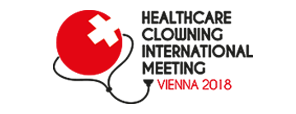Conference Connecting Culture, Health and Science:
A springboard for interdisciplinary discoveries
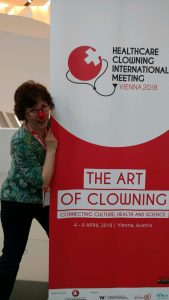 In April, five members of Boston’s Hearts & Noses Hospital Clown Troupe traveled to Vienna, Austria, for the three-day Healthcare Clowning International Meeting 2018 (HCIM). They joined with 400 people from 50 countries in the largest conference ever of its kind, covering such topics as ‘Clowns in the Healthcare System’ and ‘The Art of Clowning.’ Major themes were: the professionalism of healthcare clowning; healthcare clowning in society; and the pillars of healthcare clowning. The Conference was hosted by RED NOSES International based in Austria. (In photo: Cheryl Lekousi)
In April, five members of Boston’s Hearts & Noses Hospital Clown Troupe traveled to Vienna, Austria, for the three-day Healthcare Clowning International Meeting 2018 (HCIM). They joined with 400 people from 50 countries in the largest conference ever of its kind, covering such topics as ‘Clowns in the Healthcare System’ and ‘The Art of Clowning.’ Major themes were: the professionalism of healthcare clowning; healthcare clowning in society; and the pillars of healthcare clowning. The Conference was hosted by RED NOSES International based in Austria. (In photo: Cheryl Lekousi)
“Just being in the company of so many like-minded individuals was the high point,” Hearts & Noses Artistic Director Kenny Raskin said. “The energy was palpable! A performance on body language was hilarious and inspiring!”
Hearts & Noses is now in its third decade. In recent years, the Troupe has dramatically expanded its clown training in order to be able to offer more visits and hours to its five Greater Boston hospital partners. Visits have increased from its first year — fewer than 500 bedside visits — to more than 3500 last year.
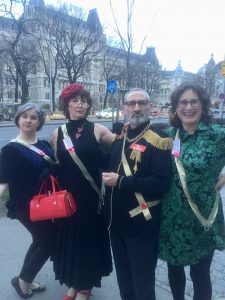 HCIM 2018 was an interdisciplinary conference connecting culture, health and science, giving healthcare clowning a new dimension. Participants included clowns, healthcare workers, doctors, advocates, and even patients. Everyone agreed about the value and unique place of clowning in medical facilities and in society as a whole. Hearts & Noses attendees shared and learned from a broad range of professionals. The fact that clowns are increasingly becoming an integral part of hospitals and other medical facilities was demonstrated by the numerous presentations in which doctors and clown artists shared the podium to explain many forms of collaboration.
HCIM 2018 was an interdisciplinary conference connecting culture, health and science, giving healthcare clowning a new dimension. Participants included clowns, healthcare workers, doctors, advocates, and even patients. Everyone agreed about the value and unique place of clowning in medical facilities and in society as a whole. Hearts & Noses attendees shared and learned from a broad range of professionals. The fact that clowns are increasingly becoming an integral part of hospitals and other medical facilities was demonstrated by the numerous presentations in which doctors and clown artists shared the podium to explain many forms of collaboration.
Joining Kenny in representing Hearts & Noses were Joyce Friedman, trainer and clown Frizzle(in photo below with blue sweater) ; Katy Bland-Brooks, clown Bumble; Jason Jedrusiak clown HONK!; and Cheryl Lekousi, Hearts & Noses Executive Director and clown Tic Toc (Photo L-R: Katy, Cheryl, Kenny and Joyce).
Cheryl said, “Because we had a strong team from our troupe, we were able to divide the program up so Kenny and other clowns attended workshops and panels on training and education while I mostly focused on organizational and managerial workshops.”
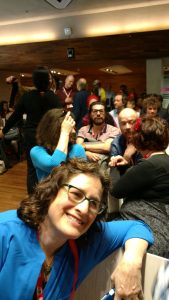 High points of the Conference
High points of the Conference
Reflecting on HCIM 2018, Kenny said, “The conference was the perfect marriage of the right and left brain. We covered the statistics, the science, the art and the joy! I think it’s wonderful that healthcare clowning is becoming more popular, more integrated within hospitals, more professional. In a sense, we are taking our work more seriously. We are seeking to be an active and respected troupe within the larger healthcare clowning community.”
For Kenny, presenter highlights included Jos Houben, whose presentation on body language called ‘The Art of Laughter’ was impactful: “He is a brilliant performer and his eye on human nature through body language was instructive.” Kenny enjoyed seeing the legendary Michael Christensen, founder of the Big Apple Clown Care Unit, and ‘grandfather’ of the healthcare clowning movement: “He is always an inspiration. We were lucky enough to have him do a workshop for our troupe last year.”
For Cheryl, one high point was a talk by Nicola Bedlington, Director-General of the European Patients’ Forum, Belgium, who discussed ‘The Empowerment of Patients: Patient-centered equitable health and psychosocial care.’ She discussed how patient-centered care is where medical clowns work and empower the child, noting the medical model of treating the whole person is being embraced all over the world.
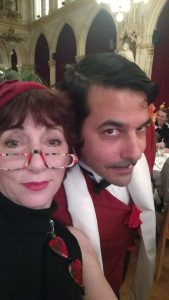 An interesting panel for Cheryl focused on the latest scientific studies from several countries showing that medical clowning brings down cortisol levels for children in hospitals, homeless shelters and refugee camps. “Watching a video of children at a refugee camp starting to play games and laugh as they catch bubbles showed how powerful it is to bring play and empowerment into an environment, and how we can reach children in the most difficult of circumstances.” She also benefitted from a workshop on Clown Tools designed to help with clown development, given by Lory Leshin of Le Rire Medicin, France, which introduced exercises to bring back to Boston.
An interesting panel for Cheryl focused on the latest scientific studies from several countries showing that medical clowning brings down cortisol levels for children in hospitals, homeless shelters and refugee camps. “Watching a video of children at a refugee camp starting to play games and laugh as they catch bubbles showed how powerful it is to bring play and empowerment into an environment, and how we can reach children in the most difficult of circumstances.” She also benefitted from a workshop on Clown Tools designed to help with clown development, given by Lory Leshin of Le Rire Medicin, France, which introduced exercises to bring back to Boston.
“The greatest value of the Conference was sharing discoveries,” said Cheryl. “We studied with teachers from around the world, heard the latest evidence-based studies, discussed how other programs run their troupes, and learned the differences between troupes and hospital protocols and how to offer the most to the children we visit.”
(Photo: Cheryl Lekousi with Olivier-Huges Terreault, Artistic Director of Teatro do Sopro)
Dr. Peter Ahlburg, an anesthetist from Aarhus University Hospital, emphasized how he sees ‘clown doctors’ as colleagues, and regularly consults them before an operation on a child patient. “The psychological, emotional aspect is, unfortunately, too often neglected in a hospital´s everyday life.“
Cheryl said, “As we continue to grow, we reaffirm our focus on keeping our organization strong and adding clowns who are well trained and available to meet the needs of each hospital program.”
Equipped with humor, pranks, improvisation, props and tricks, Hearts & Noses clowns are committed to conquering fear and gloominess using a different kind of therapy. Cheryl says, “We’re excited to be part of this international movement, visiting young patients at their bedside, bringing cheer, encouragement and laughter, helping them regain some balance and hope. Each of us returned to Boston even more energized, enthusiastic and inspired.”
All agreed that, as healthcare clowns are increasingly becoming an integral part of the hospital environment, there is a serious need for professionalization and more research into its benefits.






